Yue Zhong
Diffusion-based Auction Mechanism for Efficient Resource Management in 6G-enabled Vehicular Metaverses
Nov 01, 2024Abstract:The rise of 6G-enable Vehicular Metaverses is transforming the automotive industry by integrating immersive, real-time vehicular services through ultra-low latency and high bandwidth connectivity. In 6G-enable Vehicular Metaverses, vehicles are represented by Vehicle Twins (VTs), which serve as digital replicas of physical vehicles to support real-time vehicular applications such as large Artificial Intelligence (AI) model-based Augmented Reality (AR) navigation, called VT tasks. VT tasks are resource-intensive and need to be offloaded to ground Base Stations (BSs) for fast processing. However, high demand for VT tasks and limited resources of ground BSs, pose significant resource allocation challenges, particularly in densely populated urban areas like intersections. As a promising solution, Unmanned Aerial Vehicles (UAVs) act as aerial edge servers to dynamically assist ground BSs in handling VT tasks, relieving resource pressure on ground BSs. However, due to high mobility of UAVs, there exists information asymmetry regarding VT task demands between UAVs and ground BSs, resulting in inefficient resource allocation of UAVs. To address these challenges, we propose a learning-based Modified Second-Bid (MSB) auction mechanism to optimize resource allocation between ground BSs and UAVs by accounting for VT task latency and accuracy. Moreover, we design a diffusion-based reinforcement learning algorithm to optimize the price scaling factor, maximizing the total surplus of resource providers and minimizing VT task latency. Finally, simulation results demonstrate that the proposed diffusion-based MSB auction outperforms traditional baselines, providing better resource distribution and enhanced service quality for vehicular users.
Generative Diffusion-based Contract Design for Efficient AI Twins Migration in Vehicular Embodied AI Networks
Oct 02, 2024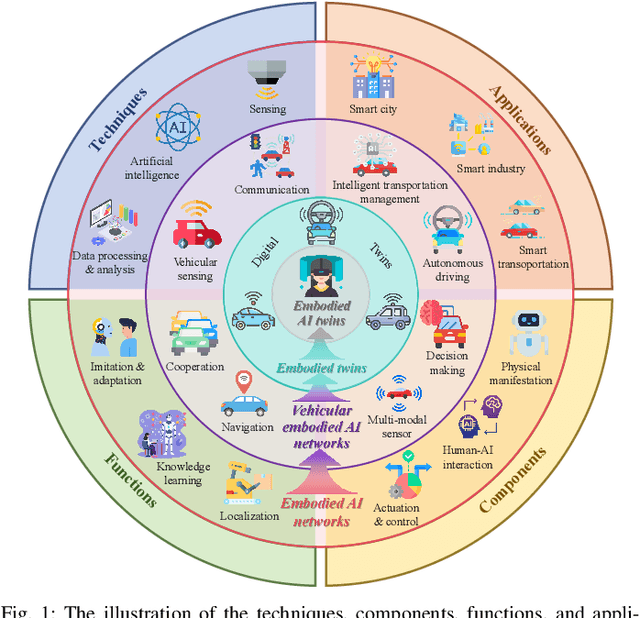
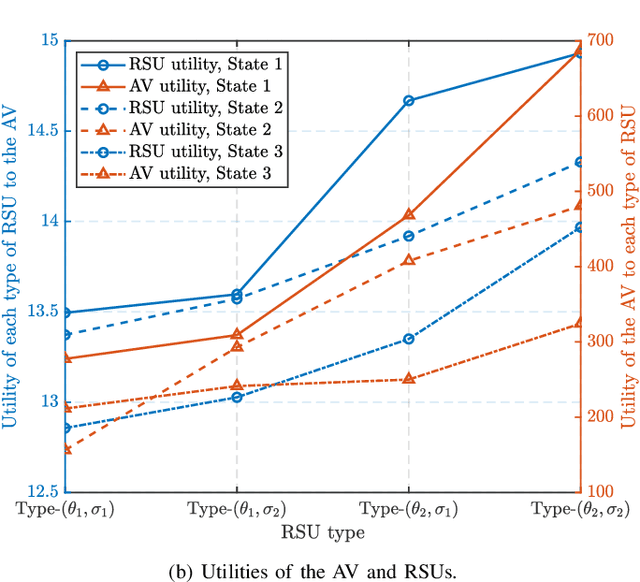
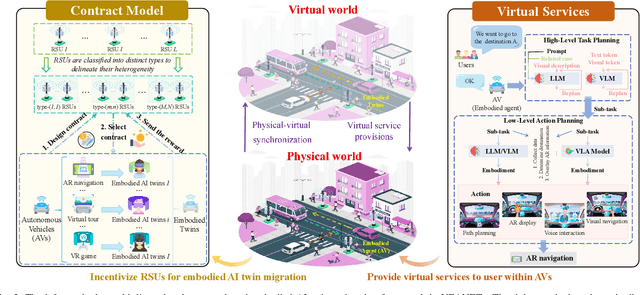
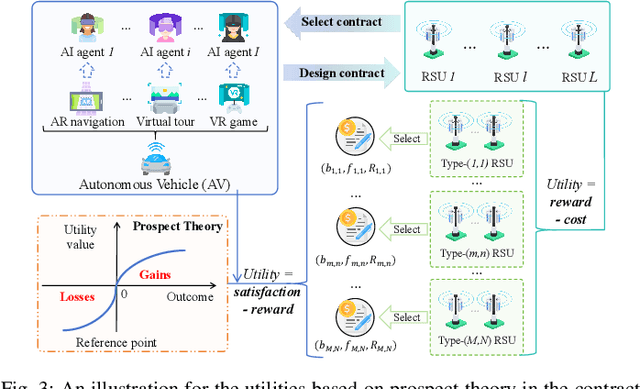
Abstract:Embodied AI is a rapidly advancing field that bridges the gap between cyberspace and physical space, enabling a wide range of applications. This evolution has led to the development of the Vehicular Embodied AI NETwork (VEANET), where advanced AI capabilities are integrated into vehicular systems to enhance autonomous operations and decision-making. Embodied agents, such as Autonomous Vehicles (AVs), are autonomous entities that can perceive their environment and take actions to achieve specific goals, actively interacting with the physical world. Embodied twins are digital models of these embodied agents, with various embodied AI twins for intelligent applications in cyberspace. In VEANET, embodied AI twins act as in-vehicle AI assistants to perform diverse tasks supporting autonomous driving using generative AI models. Due to limited computational resources of AVs, these AVs often offload computationally intensive tasks, such as constructing and updating embodied AI twins, to nearby RSUs. However, since the rapid mobility of AVs and the limited provision coverage of a single RSU, embodied AI twins require dynamic migrations from current RSU to other RSUs in real-time, resulting in the challenge of selecting suitable RSUs for efficient embodied AI twins migrations. Given information asymmetry, AVs cannot know the detailed information of RSUs. To this end, in this paper, we construct a multi-dimensional contract theoretical model between AVs and alternative RSUs. Considering that AVs may exhibit irrational behavior, we utilize prospect theory instead of expected utility theory to model the actual utilities of AVs. Finally, we employ a generative diffusion model-based algorithm to identify the optimal contract designs. Compared with traditional deep reinforcement learning algorithms, numerical results demonstrate the effectiveness of the proposed scheme.
Tiny Multi-Agent DRL for Twins Migration in UAV Metaverses: A Multi-Leader Multi-Follower Stackelberg Game Approach
Jan 18, 2024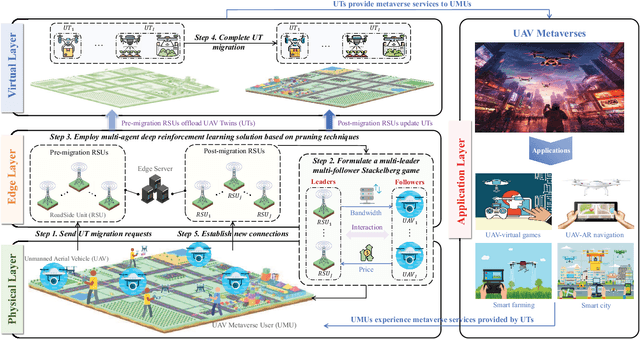
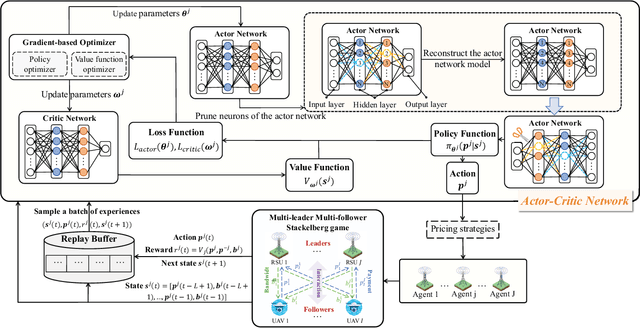
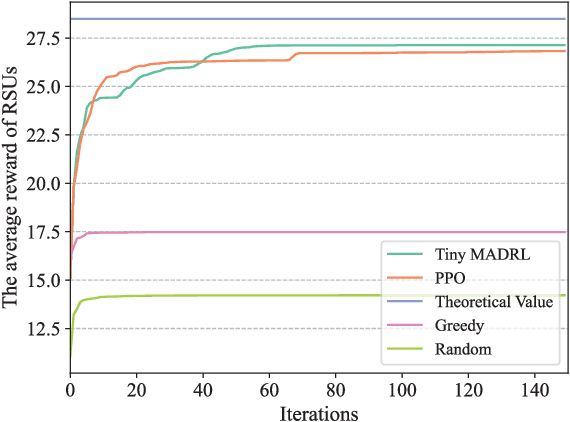
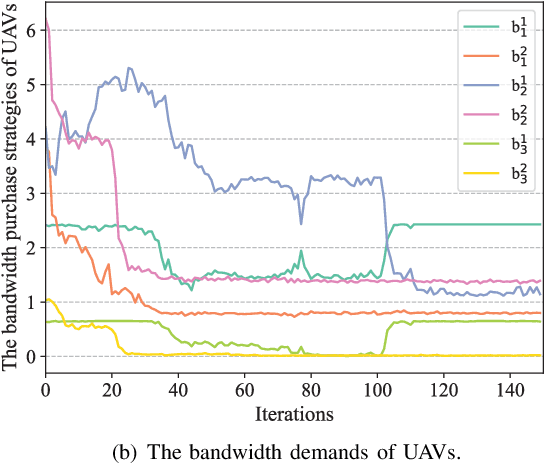
Abstract:The synergy between Unmanned Aerial Vehicles (UAVs) and metaverses is giving rise to an emerging paradigm named UAV metaverses, which create a unified ecosystem that blends physical and virtual spaces, transforming drone interaction and virtual exploration. UAV Twins (UTs), as the digital twins of UAVs that revolutionize UAV applications by making them more immersive, realistic, and informative, are deployed and updated on ground base stations, e.g., RoadSide Units (RSUs), to offer metaverse services for UAV Metaverse Users (UMUs). Due to the dynamic mobility of UAVs and limited communication coverages of RSUs, it is essential to perform real-time UT migration to ensure seamless immersive experiences for UMUs. However, selecting appropriate RSUs and optimizing the required bandwidth is challenging for achieving reliable and efficient UT migration. To address the challenges, we propose a tiny machine learning-based Stackelberg game framework based on pruning techniques for efficient UT migration in UAV metaverses. Specifically, we formulate a multi-leader multi-follower Stackelberg model considering a new immersion metric of UMUs in the utilities of UAVs. Then, we design a Tiny Multi-Agent Deep Reinforcement Learning (Tiny MADRL) algorithm to obtain the tiny networks representing the optimal game solution. Specifically, the actor-critic network leverages the pruning techniques to reduce the number of network parameters and achieve model size and computation reduction, allowing for efficient implementation of Tiny MADRL. Numerical results demonstrate that our proposed schemes have better performance than traditional schemes.
Deep Sketch-Based Modeling: Tips and Tricks
Nov 17, 2020



Abstract:Deep image-based modeling received lots of attention in recent years, yet the parallel problem of sketch-based modeling has only been briefly studied, often as a potential application. In this work, for the first time, we identify the main differences between sketch and image inputs: (i) style variance, (ii) imprecise perspective, and (iii) sparsity. We discuss why each of these differences can pose a challenge, and even make a certain class of image-based methods inapplicable. We study alternative solutions to address each of the difference. By doing so, we drive out a few important insights: (i) sparsity commonly results in an incorrect prediction of foreground versus background, (ii) diversity of human styles, if not taken into account, can lead to very poor generalization properties, and finally (iii) unless a dedicated sketching interface is used, one can not expect sketches to match a perspective of a fixed viewpoint. Finally, we compare a set of representative deep single-image modeling solutions and show how their performance can be improved to tackle sketch input by taking into consideration the identified critical differences.
 Add to Chrome
Add to Chrome Add to Firefox
Add to Firefox Add to Edge
Add to Edge